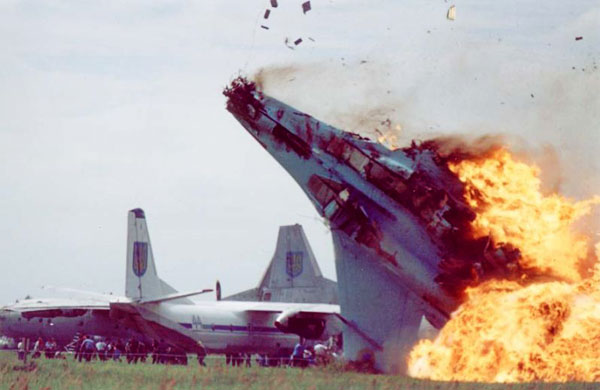
SU-27 - $$3.95
The Sukhoi Su-27 is a one-seat Mach-2 class jet fighter plane originally manufactured by the Soviet Union, and designed by the Sukhoi Design Bureau. It was intended as a direct competitor for the large American fourth generation fighters, with long 2,193 mile range, heavy armament, sophisticated avionics and high agility.
The SU-27 Russian Fighter Jet
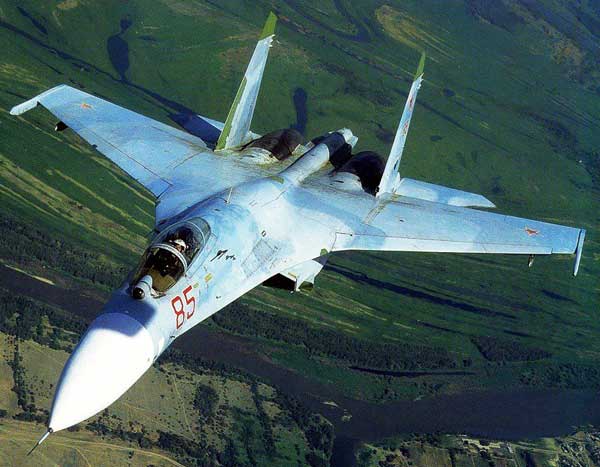
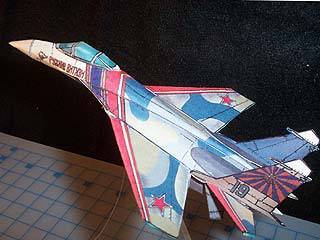
Another very special modern Soviet jet aircraft. This model is accurately decked out in Russian Air Team colors. Serious modelers have commented favorably on the simple, yet accurate, construction techniques of our jet fighters.
You'll appreciate the extra effort to bend and form cardstock to work a little magic when you see how much is accomplished with so few pieces.
Victor Pugachev's amazing demonstration at the Paris Air Show proved the Su-27 (Flanker-B) he flew to be an immensely capable dog fighter and its non-stop flight to Le Bourget from the USSR, on internal fuel only, confirmed a long range capability ideal for this interceptor, designed to keep intruders from the country's borders....
Someone from our command ordered the Jets & Aerospace CD. We are making the Soviet aircraft models for visual aids dealing the Aircraft threat recognition. The detail is just terrific. The MiG-29, the SU-27, and the other aircraft are just terrific. J. E. Thompson USMC
Sukhoi Su-27 Flanker
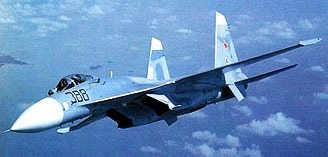
Victor Pugachev's amazing demonstration at the Paris Air Show proved the Su-27 (Flanker-B) he flew to be an immensely capable dog fighter and its non-stop flight to Le Bourget from the USSR, on internal fuel only, confirmed a long range capability ideal for this interceptor, designed to keep intruders from the country's borders.
Flanker began as a design study in 1969. resulting in the Model 1021 which flew in 1977. followed in the SOs by the special P-42 which has broken 27 world records for rate of climb and sustained altitude, surpassing those set by the McDonnell Douglas 'Streak Eagle".
Prior to production, the Su-27 underwent a major reworking, curved wingtips giving way to a straight missile launch rail, the tail cone being extended beyond the two engines, tail fins (originally positioned over the engines) were moved outwards onto independent booms and ventral strakes added. Two prominent wing fences on each wing were dispensed with and the nose wheel leg shifted from the front to the rear of its bay.
Production aircraft also have the benefit of a computerized fly-by-wire system which inputs control movements in yaw and roll by activating taileron's only (+16 degrees/-21 degrees in movement), there are no ailerons. Leading edge flaps cover all but a few outermost inches of the wing. landing, take-off and maneuvering affected by trailing edge flaps and a large dorsal airbrake.
The mainly titanium airframe can withstand a maximum force of +9g and has two Lyulka AL-31 F, 27.5571b thrust turbofans, supplying sufficient power to push Flanker to beyond Mach 2.3. Unlike the smaller MiG-29. The Su-27 intakes have no obvious protective doors to prevent ingestion of debris during take-off and landing, but do have internal slats to do the same job.
In addition, the nose wheel has a stone guard to stop stones, etc.. being kicked up from the large, low pressure tire's when using rough airstrips. No Fulcrum style upper wing intake louvers are in evidence, but under each intake is a series of thin suction relief doors no doubt invaluable for the "cobra" maneuver to maintain airflow at high angles of attack.
A large nose radome houses a pulse Doppler radar which, in conjunction with the IRST (Infra-Red Search and Track)~and integral laser ranger in front of the cockpit, gives the pilot (using his helmet mounted target designation system) amble information to launch AA-10 Alamo missiles. A combination of short range infra-red guidance Alamo-B, short range radar guided Alamo-A and longer range radar guided Alamo-C are available, all using the same missile airframe, but with an extended body for the long range version. AA-8 Aphid and new AA- 11 Archer may also be carried for short range work (presumably on the interception photos show one Alamo-C fitted under each intake, two Alamo-A in the valley between the intake trunking and one Alamo-B on each inner wing pylon. The outermost pylon appears to have a dielectric body and may be solely for ECM equipment.
Each weapons station is prevented from sitting directly onto the aircraft surface by paired supports, leaving a gap in the middle. Those on the inner wing pylons being particularly long and fluted at the pylon end. Backing up the missile fit is a single barrelled 30mm cannon buried in the starboard wing root.
Cockpit instrumentation currently lacks multi-function display screens. but a "glass" cockpit is being developed to replace the dials in use now. The additional cockpit in the Flanker-C trainer has been built up to a greater extent than that of the Fulcrum two Seater, allowing a good view for the rear pilot. Apart from conversion training. Flanker-C is said to be tasked for long missions where two crew can share the workload, that is why the radar is retained, unlike Fulcrum-B.
Flanker-B entered service with the PVO Strany (Soviet air defense force) around 1986 and no exports have so far been revealed. However, the Soviet delegation at Le Bourget showed film of Su-27s being launched off ski-jumps and recovered using arrestor wires, so Soviet Navy acquisition seem inevitable. Trials have also been conducted with a Model 1024, fitted with canards sprouting from modified LERX, but this configuration is not expected to enter production.
Not until 1 982 was It given the uninspired reporting name of Flanker. Within the 0KB it was known as the T-10, the first prototype being the T-1 0-1. At one point it was thought in the West that Ram K had variable sweep wings, but this misconception was caused by poor definition on satellite photographs.
Flanker was dimensionally rather larger even than the F-15 Eagle. Two augmented turbofans set in widely spaced nacelles were reminiscent of the F-14, and their straight-through' layout gave rise to speculation that the Soviets were having trouble with compressor stalls caused by disturbed airflow, a problem encountered by the American carrier fighter. The inlets were raked at about 600, indicating speeds in excess of Mach 2, with two-dimensional multi-shock horizontal ramps, set beneath Straight edged wing strakes.
The cockpit was mounted centrally behind a huge radome, with what appeared to be a fairly small bubble canopy. Tall vertical fins of very high aspect ratio were set forward above the engine nacelles in the manner of the Hornet. The wings, of moderate sweep and rather high aspect ratio for a fighter, with simple blended body strakes extending to the front edge of the cockpit, and two fences each side to Inhibit spanwise flow, had rounded tips.
To take advantage of relaxed stability and thereby enhance maneuver capability, a four channel analogue fly-by-wire system was used, with no manual reversIonary system, Sukhoi having gained experience with this on the 1972 vintage Su-100 high speed research aircraft. Air-to-air weaponry consisted of eight missiles and a 30mm cannon.
First flight took place on May 20, 1977. with Sukhoi chief test pilot Malor Vladimir S. llyushin, the son of the founder of the llyushin 0KB, at the controls.
Problems were encountered early in the flight test program. Directional stability was inadequate at speeds exceeding Mach 2, while operational studies showed Flanker A, as the original variant was called, to be considerably inferior to the P-i 5, having less than 75 percent of the capability of the American fighter. according to Soviet sources. Faults were also found in the FBW software, and these cost the lives of two Sukhoi test pilots, one of whom was Evgeny Soloviev.
Mass production of a fighter considerably inferior to an adversary that had already been in service for several years was not what the Kremlin wanted, and the decision was taken to revamp the whole project.
The redesigned Flanker B first flew on April 20 1981, again piloted by Vladimir llyushin. A production standard aircraft, it was obviously very different from the original, and some Soviet sources stated mat the only parts that remained the same were the K-36DM ejector seat and the main gear. This was of course an exaggeration, but only a slight one. In conversation with Major General llyushin, as he now is, the writer was told that while the center section remained the same, virtually everything else was revised. Even the cockpit was enlarged and raised, and given a large semi bubble canopy, broken astern by a single frame, for good all-round vision.
Flanker B is powered by two Lyulka AL-31F augmented turbofans, spaced slightly further apart than they had been on Flanker A. The wedge intakes appear to have changed little, although two rows of vertical louvers are now present on the side walls, and larger auxiliary intake louvers are mounted underneath. On film released of the T-1 0-1, what appeared to be small housings, possibly for IRST or LLTV, occupied the bottom outboard corners of the inlets. On Flanker B these had vanished. The steeply raked inlet sides became vertical for the bottom few inches to minimize spillage drag. Retractable wire mesh guards protect the compressor face from FOD ingestion and bird strikes, allowing operation from semi prepared or damaged runways.
The wings had altered considerably. The original straight edged strakes had been replaced by ogival LERXs very similar to those of the F-16, while the fences had been deleted. Full span flaps had appeared on the formerly fixed leading edge to augment the half span flaperons on the trailing edge. Both surfaces are manually controlled for take-off and landing, and computer controlled during flight to give a measure of variable camber. The previously rounded tips were squared off to carry two extra missiles, the rails for which acted as endplates to inhibit spanwise flow. This brought the total of AAMs carried to 10.
The stalky single wheel nose gear, previously set beneath the front of the cockpit and retracting rearwards, was moved to a position aft of the cockpit and made to retract forward. This had the effect of improving ground handling by bringing more weight onto the nose wheel, which in accordance with Soviet practice had a mud/stone guard. The single wheel main gears retract forward into the wing roots, while the main ~er doors, which had previously doubled as speed brakes, were replaced in this capacity by a dorsal speed brake located behind the cockpit in a similar manner to that of the F-15. At the rear of the fuselage, a long beaver tail appeared, with a bullet fairing to reduce base drag. This also housed a braking parachute.
The angular vertical tail surfaces appear to have a broader chord than on Flanker A, with a correspondingly lower aspect ratio, and with raked tops. They are now mounted on shelves outboard of the engines Instead of on top of the' cowlings, as an aid to directional stability at high Mach numbers. At the same time, two ventral fins appeared on the undersides of the shelves to provide extra stability at high alpha. The shelves have. another advantage inasmuch as they provide a block for the horizontal tails to pivot against. The horizontal tall surfaces themselves have been reduced in area and span, and now have a typically Soviet cropped' appearance.
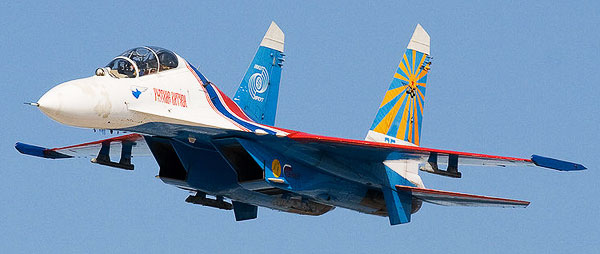
In these days of stand-off weaponry, intruders should ideally be intercepted as far out from the borders or the coastline as possible. There are two basic ways of doing this. Either the interceptor takes off, climbs out, then makes a high speed dash towards the target, or it flies Out at economical cruising speed beforehand to a patrol line, on which it loiters for an extended period, wailing for trade. Either way it needs an awful lot of fuel.
The Western approach to this is twofold; air refueling from tankers, and jettisonable external tanks. External tanks also have their disadvantages. Firstly they sterilize pylons which could otherwise be used for weapons carriage. Secondly they add considerably to the radar cross section (ROS) of the aircraft, increasing the range at which it can be detected, and the probability of it being detected. Thirdly the added drag reduces performance significantly.
For example, the F-4E Phantom armed with four AIM-7E Sparrows has an absolute supersonic ceiling of 55,000ft and a Vmax of Mach 2.14. Add two jugs on the wings and a third on the center line and these figures reduce to 44,000 ft and Mach 1.71 20 percent in each case! Rate of climb and acceleration also suffer.
Finally, jugs are an Inefficient way of carrying extra fuel; a rough rule of thumb is that half the fuel in external tanks is used In getting the other half there, so range and endurance are not increased by as much as might appear to be the case from a simple comparison of fuel weights.
The alternative is a large internal fuel capacity. This keeps the ACS down, leaves all hard points free for ordnance, and reduces drag, thereby improving performance at high weights. The disadvantages are a rather heavier structure and possibly even a larger fighter than might otherwise have been the case: the inability to shed weight rapidly prior to combat by jettisoning tanks, arguably greater vulnerability to battle damage, and probably reduced g' loading at high weights.
At Flanker's initial design stage, air-refueling was not a realistic option; Soviet capability in this field was rudimentary. Furthermore tankers can only operate effectively within a secure zone: they need protection, which demands extra fighter cover. Flanker B has therefore no flight refueling capability, although it is anticipated that this may be added in the near future, in the overload condition. Flanker B holds about 22,046 lb of Internal fuel. although for normal missions only between half and three quarters of this is carried. A digital fuel control system keeps the center of gravity within limits. Like most Western types, Flanker is a foam jet, with polystyrene foam in the fuel tanks to reduce the chance of an explosion following battle damage.
Maximum fuel confers a range of 2485 miles which translates into a combat radius of 932 miles or a very healthy extended loiter time at a distance of 342 miles from base. Flanker must also have an excellent supersonic Interception radius, which is believed to exceed 300 miles.
Flanker B's cockpit is large and spacious, and the K-36DM zero/zero ejection seat Is firm but comfortable. The pilot sits up high for a good all-round view, with the cockpit sills at about elbow level. Rearward vision is excellent, matching anything the West has to offer, and is aided by three rear view mirrors on the canopy bow, The wrap-around windshield is hardly obstructed by the large twin combiner glass HUD, and the bulging IRST (infra-red search and track) housing located just in front of the cockpit, which from the ground appears likely to obstruct the forward view, is not obtrusive.
It is when one glances down that the difference between Flanker and Western fighters becomes apparent, with a plethora of analogue instrument dials and switches. The avionics display ORT is high on the right of the dash; the only other concession to modernity being a dedicated weapons station display just below the HUD, although some attempt at HOTAS has been made, as is evidenced by the battery of buttons and switches on the control column.
Little has been released about the capability of the radar except that it is a coherent pulse Doppler multimode type. The size of the radome indicates a very large antenna, larger than that of any Western tighter, and inferior only to that of the MiG-31 Foxhound. Antenna size can be linked to long range, and high prf (pulse repetition frequency) Is probably used for maximum power Output. Maximum detection range is estimated to be about 150 miles and maximum tracking range 114 miles . While capable of tracking multiple targets, it has been stated that Flanker B 's radar has no multiple engagement capability, although the lack lies in the missiles rather than the system.
The detection/attack system is very comprehensive. Linked to the radar is the IRST. One method of usage is to detect by radar, then hand off the contact to the IRST for further tracking, either putting the radar into dummy load or using it to scan other areas. If the aircraft being tracked passes behind a cloud, which is of course opaque to infra-red, the IRST can automatically cue the radar to re-acquire the target.
IAST is a passive device, with no tell-tale emissions to warn the target that it is being tracked. For close range guns work, it is linked to a laser rangefinder which is far more accurate than radar ranging. The whole is linked with a helmet mounted target designator, which allows off bore sight missile launches.
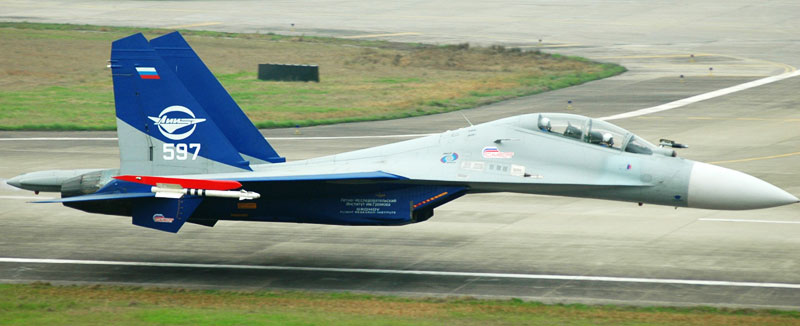
The effectiveness of this must be open to question. It is asking a lot of a missile to turn through perhaps 2700 and acquire the target, and it is going to bleed off an awful lot of energy in doing so. Lets do a few sums. If the missile can sustain an average of 30g, its radius of turn window exceed 2.3 mi and its rate of turn will be about 14 deg/sec.
If the target is inside this distance at the time of launch, acquiring and homing, given the limited look angle of the seeker head, is going to be very difficult, even assuming a preprogrammed oblique loop flight path even climb the eleven rung ladder and sit in the cockpit. It was real! What was more, the Sukhoi people could hardly have been more helpful in answering questions, all the while pressing brochures, key rings, and Other gadgets into our eager little hands.
In the air. Flanker Showed formidable powers of maneuver, the now obligatory high alpha fly past being entered from the final corner of a square loop, neglecting the usual careful setting up. Then came the spectacular Cobra maneuver performed by Victor Pugachev in the single seater. Starting from level flight at about 277 miles, the nose suddenly pitched up through the vertical, to an angle estimated at over 1000 ii, the space of just over one second. The initial impression was of total loss of control, and the watching crowd audibly gasped. It then snapped down almost as quickly, tile big fighter recovering into a slightly nose down altitude. Little speed loss was evident, and most certainly the engines were tolerant of disturbed airflow.
Such instantaneous high alpha had never before been seen in the West, and naturally it caused a lot of comment. Firstly It should be said that Flanker is normally limited to 300 alpha, although this can be manually over-ridden, By implication, the Cobra was only available in a combat emergency. Secondly, tile high alpha low speed pass demonstrated was not essentially different from those of the F-1B or F/A-1B. indicating perhaps that Soviet aerodynamics are not radically different, juSt rather more benign during instantaneous maneuvers.
Sukhoi originally presented the Cobra as a valid combat maneuver, to force an opponent to fly through. Frankly I doubted this as it implies an opponent closing from the rear quadrant for a guns attack. Spatial displacement is an essential port of defense against any attack, but the Cobra falls to provide this. All it does is to present a larger, i.e. platform target.
However, what the Cobra does demonstrate Is the ability to hose the nose around In an extremely rapid manner. Combined with tile helmet mounted sight, this would bring many more adversaries into the heart of the off -bore sight missile envelope, It has since been confirmed that only four test pilots have been cleared to execute this maneuver.
The design of the Su-27 is now into early middle age, and various upgrades are now in the pipeline. An experimental variant, the T-1 0-24. first flew With canard foreplanes as far back as 1985, and the same machine was fitted with 20 vectoring nozzles in 1988 to investigate enhanced maneuverability. While the F-IS STOLIMTD needs foreplanes to counter nozzle-induced pitch moment, it has been stated that the thrust vectoring Flanker can fly with or without them. The canards were used to improve the lift coefficient for the conventionally nozzled carrier-based variant.
Tills last presumably reduces internal fuel capacity, as in flight refueling Is to be incorporated. Fuel replenishment is carried out using the buddy system, with one Flanker O refueling the other. This is obviously a waste of scarce resources, but in such time as the Soviet Navy can produce a carrier compatible tanker (or convertible attack aircraft) there is no real alternative.
Also due to enter service shortly Is a thrust vectoring Flanker with 2D nozzles. As at the beginning of 1991, it is still undergoing relIability trials. If Flanker B is a bit of a handful for an opponent, this one will be even worse!
Other upgrades are also planned. New build Flankers will contain a high proportion of composites, while the old fashioned cockpit is being completely redesigned, reportedly with four CRT displays and a side stick controller to replace the conventional control column.
How good is Flanker! That is a difficult question to answer while knowing nothing of the capability of the radar, and the lack of an AMRAAM equivalent also represents a serIous weakness. In close combat it is as good as any, and better than most, although its large size and lack of low observable's must to some degree offset its extreme agility. But the short 4'. answer is very good indeed.
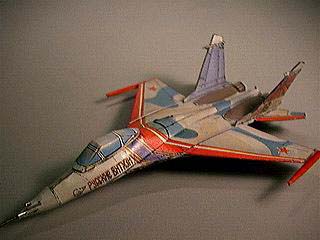 This
is a close up photo of the Cyber Model version of the SU -27. This
is a close up photo of the Cyber Model version of the SU -27.
|
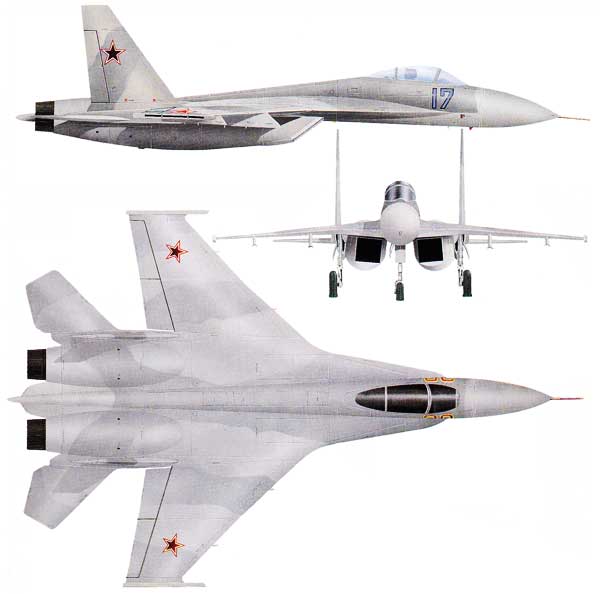
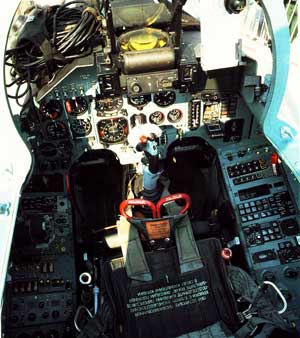 |
Cockpit of the Sukhoi Su-27. |
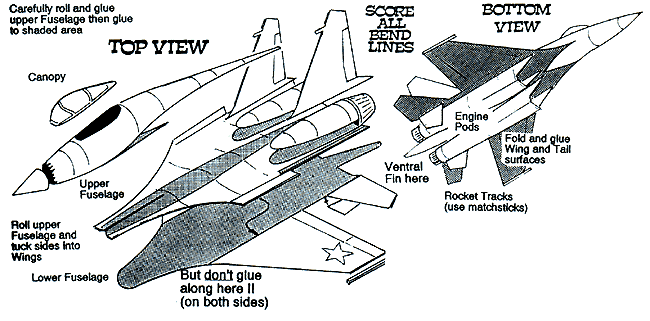
Specifications for the Sukhoi Su-27
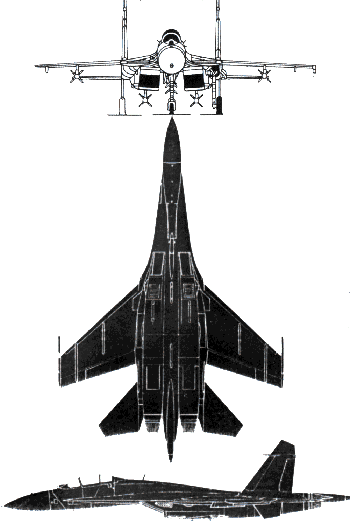 |
Length: 72 ft Wingspan: 48 ft 3 in Leading edge sweep: 42° Height: 19 ft 6 in Wing area: 667 ft² Empty weight: 36,100 lb Loaded weight: 51,650 lb Max takeoff weight: 67,100 lb Powerplant: 2× Saturn/Lyulka AL-31F turbofans, 27,600 lbf each Performance Maximum speed: Mach 2.35 (1,550 mph) at altitude Range: 2,070 mi at altitude; (800 mi at sea level) Service ceiling: 62,523 ft Rate of climb: 64,000 ft/min Wing loading: 76 lb/ft² Thrust/weight: 1.09 Armament 1 × 30 mm GSh-30-1 cannon with 275 rounds 17,600 lb on 10 external pylons Up to 6 × medium-range AA missiles R-27, 2 × short-range heat-seeking AA missiles R-73 Upgraded Su-27SM is capable of using R-77 instead of R-27 |
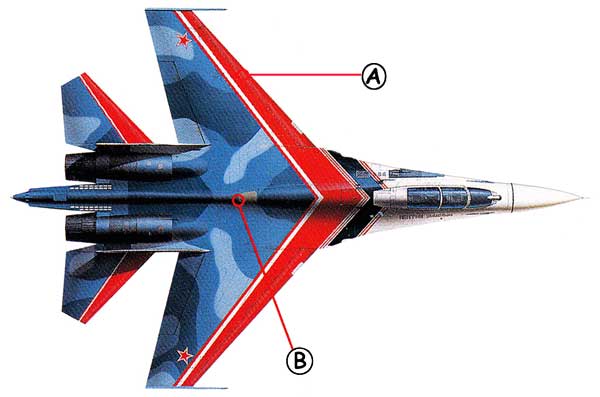 |
|
| A: The sharply swept wing leading edge extensions provide extra lift at high angles of attack, and contribute to the Su-27's extraordinary agility. | B: The "Flanker" bears a marked resemblance to the smaller MiG-29 because both aircraft use an advanced wing designed at TsAGI, the Central Aerodynamics Institute, the Russian equivalent of NASA. |
 |
||
| A: The Su-27U8's tailfins are taller than those on other "Flankers," with an extra section added at the base. | B: Although primarily designed as a two-seat trainer, with a stepped cockpit giving trainee and instructor good forward visibility, the Su-27UB has full combat capability. | C: On combat "Flankers" the long fuselage protrusion houses an aft-looking radar. |
| D: The ventral fins fitted to all "Flankers" greatly improve spin recovery. | E: The air intakes are fitted with a mesh debris screen that remains closed until the nosewheel has lifted off the ground. | F: A glazed ball mounted in front of the windscreen houses a laser rangefinder and an infrared search and track system, which can detect enemy aircraft at up to 45 mi. |
